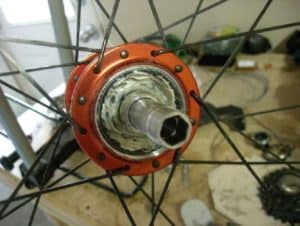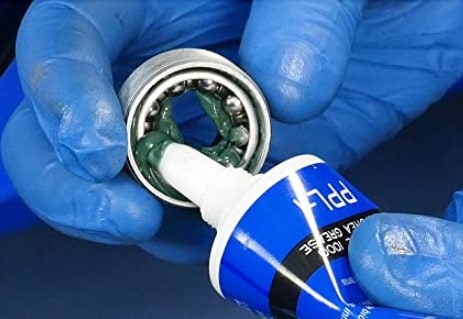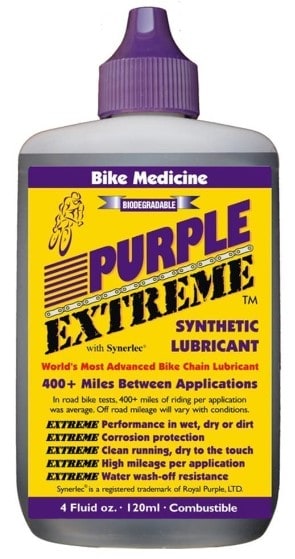As a rule of the thumb, if a bicycle part has threads or works by moving, it needs greasing. However, using the wrong lubricants can adversely affect a bike’s efficiency or cause damage. So, you ask, “What kind of grease should I use on my bike?”
There are many types of bike greases that you can use on different bike parts. All the same, any multi-purpose automobile grease will work well on most bike parts. However, for ceramic bearings, you will need to use ceramic-safe grease.
As for fiber-framed bikes, you shouldn’t use grease on the seat post. Instead, use carbon assembly paste. However, for bearings and other moving parts, grease will be alright.

What Kind Of Grease Should I Use On My Bike Bearings?
On almost all moving parts of a bicycle, you will find different types of bearings installed. Therefore, you need to understand the best grease for different bike parts, especially the bearings.
Whether it’s the open or the sealed bearings, they all need lubrication.
Applying the wrong grease on your bike bearings can be disastrous. So, what kind of grease is ideal for bike bearings?
Before you go for a particular type of grease, you need to consider what kind of bearings your bike has.
Mainly, there are standard steel bearing and ceramic ones. If your bike has ceramic bearings, then you need ceramic-safe grease, which will maximize your bike’s performance and without damaging the bearings.
One of the best ceramic greases is the Finish Line Ceramic Grease, made of high-quality ingredients and features the latest ceramic technology.
On the other hand, steel bearings can use any multi-purpose or bike grease.
How Often Should I Grease My Bike Bearings?
Generally, bearings need grease for only one reason; to reduce friction. Therefore, so long as the present lubricant is working well, you don’t need to add more or change.
Actually, you don’t grease a bike because a certain time has elapsed. Actually, that is an old misconception that doesn’t hold water.
On the contrary, the greasing frequency will depend on how much you use your bike and where you ride.
For example, anyone who rides on the road a few times a week may grease their bikes after one to two years.
On the other hand, off-road riders will need to grease their bike bearings after about 3-9 months due to the collection of dirt from the lugged terrains.
Notably, high-quality products such as the Park Tool PolyLube 1000 Bicycle Grease will work best for cyclists who love taking the dirt roads.
After, you may need to grease your bicycle after a few pressure-washes since the bearings will lose some substantial amounts of lubricant.
All the same, sealed bearings are hard to grease. Therefore, if they wear out, the best solution is to be new ones.

What Is The Best Bike Grease For Pedals
Although we observed that you could use any regular automobile grease, there are different types of greases meant for various parts and purposes. Nevertheless, that shouldn’t scare you because, in essence, any grease can work for your pedals.
I addition, some factors will determine what type of grease is best for you. One of the main factors to consider is the types of pedals your bike has.
Mainly, there are two types of bike pedals; the clipless (also known as clip-in) and the flats (platform). You will mostly find the clip-ins on bikes meant for professional riding, while the latter is found on bikes meant for recreational riding.
Mainly, platform pedals are used for stunt riding, freeride, dirt jumping, and bike motocross.
Therefore, the flat pedals require more maintenance as compared to clipless pedals. As a result, they need thicker grease than clipless pedals.
However, the grease shouldn’t be too thick to avoid creating unnecessary friction in the pedals.
Notably, regular grease is ideal for pedals of any type.
Bike Grease Vs. Lube
Notably, the primary function of both grease and other lubricants is to reduce friction. However, different parts on the bike require different lubrication.
Mostly, grease is ideal for parts that you don’t take apart frequently, while the lube is for pieces that are more accessible and need frequent maintenance.
Notably, grease has a higher viscosity, and it can remain on the applied surfaces for a long time. In addition, it can withstand extreme conditions.
Also, grease is ideal for parts that make slow or small movements, such as the head tube bearings, bottom brackets, and wheel bearings. In addition, the other part where greasing is essential is on the shifters.
On the other hand, lubes such as the BIKE MEDICINE Purple Extreme Performance Synthetic Chain Lubricant is ideal for parts that are more accessible.
For such parts, bike lubes are an excellent investment since they don’t break down easily in extreme conditions, no dirt collection, and are not easily washed away.
In addition, since lubes are less viscous than grease, they can’t get between tight surfaces such as the chain links.
In that case, you can use lubes on parts such as the chain, derailleurs, brake pivots.

Bike Grease Alternative – What Can I Use Instead Of Bike Grease?
If you are a beginner cyclist, you could be wondering whether you have many options other than using bike-specific grease.
Don’t worry. In most bike forums, this is a common question from new cyclists.
Unfortunately, there is so much noise on those forums as everyone tries to explain a hack or two, but what is the legit alternative to bike grease.
First, regular automotive grease works fine on bicycles. The downside of regular grease is that if you over-apply, it slows you down.
All the same white Lithium grease will work fine on almost every part of the bike that needs greasing. In addition, the grease is water-resistant and can tolerate extreme temperatures.
Actually, white lithium grease can operate in a place with temperatures ranging from -25 to 130 degrees Celsius.
Therefore, for a long-term alternative to bike grease, you can go for Permatex 80345 White Lithium Grease. Notably, this grease is an all-purpose lubricant, and it can withstand extreme conditions.
Other Frequently Asked Questions
1. Is Lithium Grease Good For Bikes?
Lithium grease is suitable for almost any other part of your bike. Mostly, “NLGI 2” is ideal since it isn’t too hard for a bicycle. As such, if used in the correct amount, it shouldn’t pose any problem other than dirt collection.
2. Is Grease Good For Bike Chain?
Using grease on a bike chain isn’t a good idea. Since grease is thick, it won’t penetrate between the pins and rollers on the chain. In addition, grease has higher viscous friction as compared to oil.
3. Is Marine Grease Good For Bikes?
Yes, marine grease will work just fine. Actually, any type of grease will work well if you apply the correct amount. All the same, for carbon fiber bikes, use carbon assembly paste for the seat post, not grease.
4. Can I Grease Sealed Bearings?
Sealed bearings come when pre-greased by the manufacturers with a 25% to 35% grease fill. Mostly, this is all that the grease will need since the greasing interval is longer than the expected lifespan of a sealed bearing.
Related Article: Should I grease my seatpost?
Final Word
So, what kind of grease should I use on my bike? Well, any grease will work just fine on your bike so long as you apply the correct amount in the right place.
Unlike the old school of thought that said you have to grease your bike regularly according to a schedule; you only need to do it once in one or two years.
Mostly, grease is needed in parts that use unsealed bearings.
In addition, there is no need to grease sealed bearings since they come pre-greased with enough grease to last them for their entire lifetime.